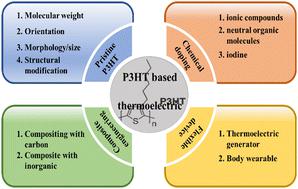当前位置:
X-MOL 学术
›
Mater. Chem. Front.
›
论文详情
Our official English website, www.x-mol.net, welcomes your feedback! (Note: you will need to create a separate account there.)
Recent progress of poly(3-hexylthiophene)-based materials for thermoelectric applications
Materials Chemistry Frontiers ( IF 7 ) Pub Date : 2024-05-08 , DOI: 10.1039/d4qm00213j Maiyong Zhu , Binqi He , Kai Zhang , Shahid Hussain , Tie Li
Materials Chemistry Frontiers ( IF 7 ) Pub Date : 2024-05-08 , DOI: 10.1039/d4qm00213j Maiyong Zhu , Binqi He , Kai Zhang , Shahid Hussain , Tie Li

|
Thermoelectric devices represent an emerging technique that holds great promise for improving energy utilization efficiency and the recovery of waste heat energy. In comparison to inorganic or metallic thermoelectric materials, conducting polymers, consisting of a carbon-based π-conjugated backbone, simultaneously possess electrical conductivity of metals and excellent mechanical properties of common plastics. To date, conducting polymers have found great potential/practical applications in various fields. As a well-known conducting polymer, poly(3-hexylthiophene) (P3HT), possessing unique physicochemical properties, is a model system to study electronic/thermal correlations and develop high-performance thermoelectric devices. In this review, state-of-the-art research progresses of P3HT-based materials in thermoelectrics are provided. First, a brief introduction to the thermoelectric effects and advantages of conducting polymers as thermoelectric modules is provided. Then, applications of both pristine P3HT and P3HT-based composites in thermoelectrics are highlighted by citing numerous representative examples. Strategies to improve the performance of P3HT-based thermoelectrics are systematically summarized. An in-depth study of P3HT was conducted, focusing on various aspects such as molecular weight, orientation, morphology/size and structural modification, since many TE factors are related to these parameters, for instance, charge mobility and electrical conductivity. Furthermore, chemical doping also demonstrates great potential in adjusting the thermoelectric performance of P3HT. Additionally, some composites containing P3HT for advanced thermoelectrics are also discussed. Then, we discuss the application and development prospects of P3Ht-based thermoelectric materials in human wearable flexible devices. Finally, the main challenges and prospects of P3HT-based materials and their applications in thermoelectrics are discussed. Hopefully, this review can inspire the development of P3HT-based thermoelectrics.
中文翻译:

聚(3-己基噻吩)基热电材料的最新进展
热电装置代表了一种新兴技术,在提高能源利用效率和回收废热能方面具有广阔的前景。与无机或金属热电材料相比,由碳基π共轭骨架组成的导电聚合物同时具有金属的导电性和普通塑料优异的机械性能。迄今为止,导电聚合物在各个领域都发现了巨大的潜在/实际应用。聚(3-己基噻吩)(P3HT)作为一种著名的导电聚合物,具有独特的物理化学性质,是研究电子/热相关性和开发高性能热电器件的模型体系。在这篇综述中,提供了 P3HT 基热电材料的最新研究进展。首先,简要介绍了导电聚合物作为热电模块的热电效应和优点。然后,通过引用大量代表性示例来强调原始 P3HT 和 P3HT 基复合材料在热电领域的应用。系统总结了提高 P3HT 热电材料性能的策略。对 P3HT 进行了深入研究,重点关注分子量、取向、形态/尺寸和结构修饰等各个方面,因为许多 TE 因素与这些参数相关,例如电荷迁移率和电导率。此外,化学掺杂在调节P3HT的热电性能方面也表现出巨大的潜力。此外,还讨论了一些用于先进热电材料的含有 P3HT 的复合材料。 然后,我们讨论了P3Ht基热电材料在人类可穿戴柔性设备中的应用和发展前景。最后,讨论了P3HT基材料及其在热电领域的应用的主要挑战和前景。希望这篇综述能够激发基于 P3HT 的热电材料的发展。
更新日期:2024-05-08
中文翻译:

聚(3-己基噻吩)基热电材料的最新进展
热电装置代表了一种新兴技术,在提高能源利用效率和回收废热能方面具有广阔的前景。与无机或金属热电材料相比,由碳基π共轭骨架组成的导电聚合物同时具有金属的导电性和普通塑料优异的机械性能。迄今为止,导电聚合物在各个领域都发现了巨大的潜在/实际应用。聚(3-己基噻吩)(P3HT)作为一种著名的导电聚合物,具有独特的物理化学性质,是研究电子/热相关性和开发高性能热电器件的模型体系。在这篇综述中,提供了 P3HT 基热电材料的最新研究进展。首先,简要介绍了导电聚合物作为热电模块的热电效应和优点。然后,通过引用大量代表性示例来强调原始 P3HT 和 P3HT 基复合材料在热电领域的应用。系统总结了提高 P3HT 热电材料性能的策略。对 P3HT 进行了深入研究,重点关注分子量、取向、形态/尺寸和结构修饰等各个方面,因为许多 TE 因素与这些参数相关,例如电荷迁移率和电导率。此外,化学掺杂在调节P3HT的热电性能方面也表现出巨大的潜力。此外,还讨论了一些用于先进热电材料的含有 P3HT 的复合材料。 然后,我们讨论了P3Ht基热电材料在人类可穿戴柔性设备中的应用和发展前景。最后,讨论了P3HT基材料及其在热电领域的应用的主要挑战和前景。希望这篇综述能够激发基于 P3HT 的热电材料的发展。






























 京公网安备 11010802027423号
京公网安备 11010802027423号